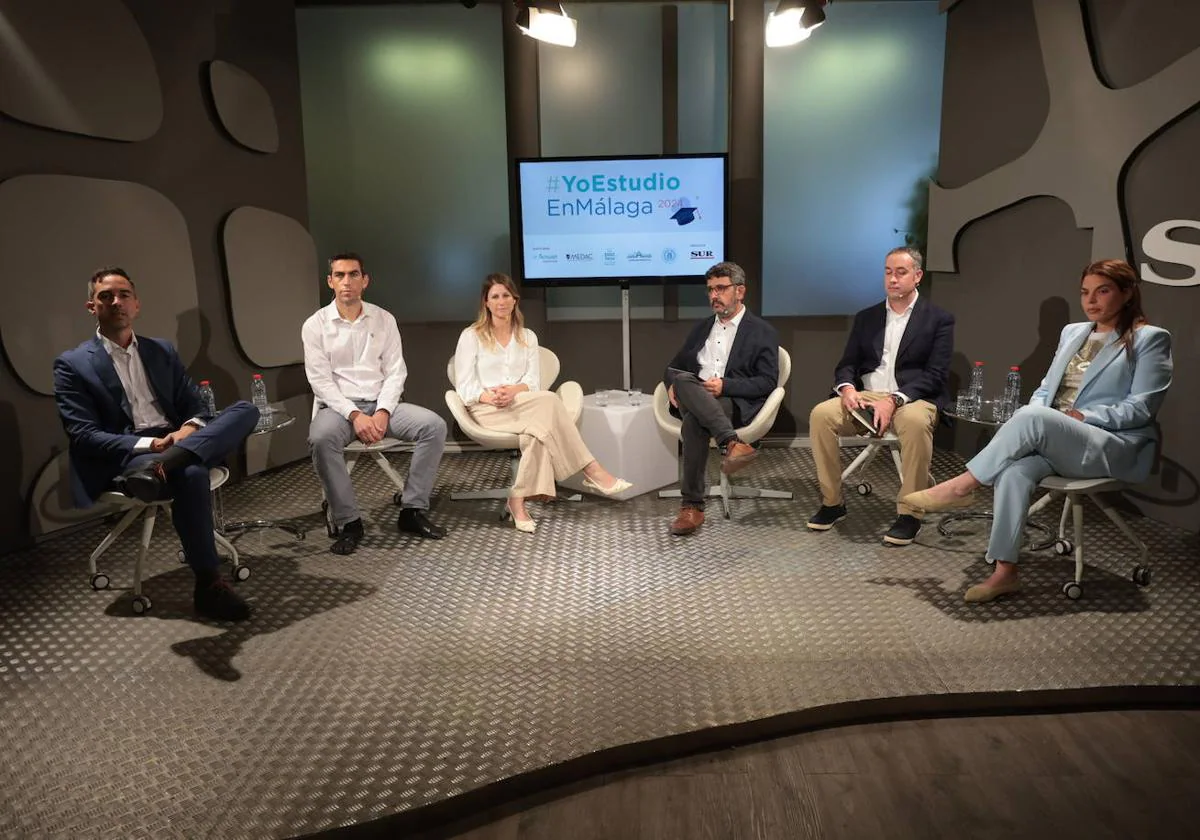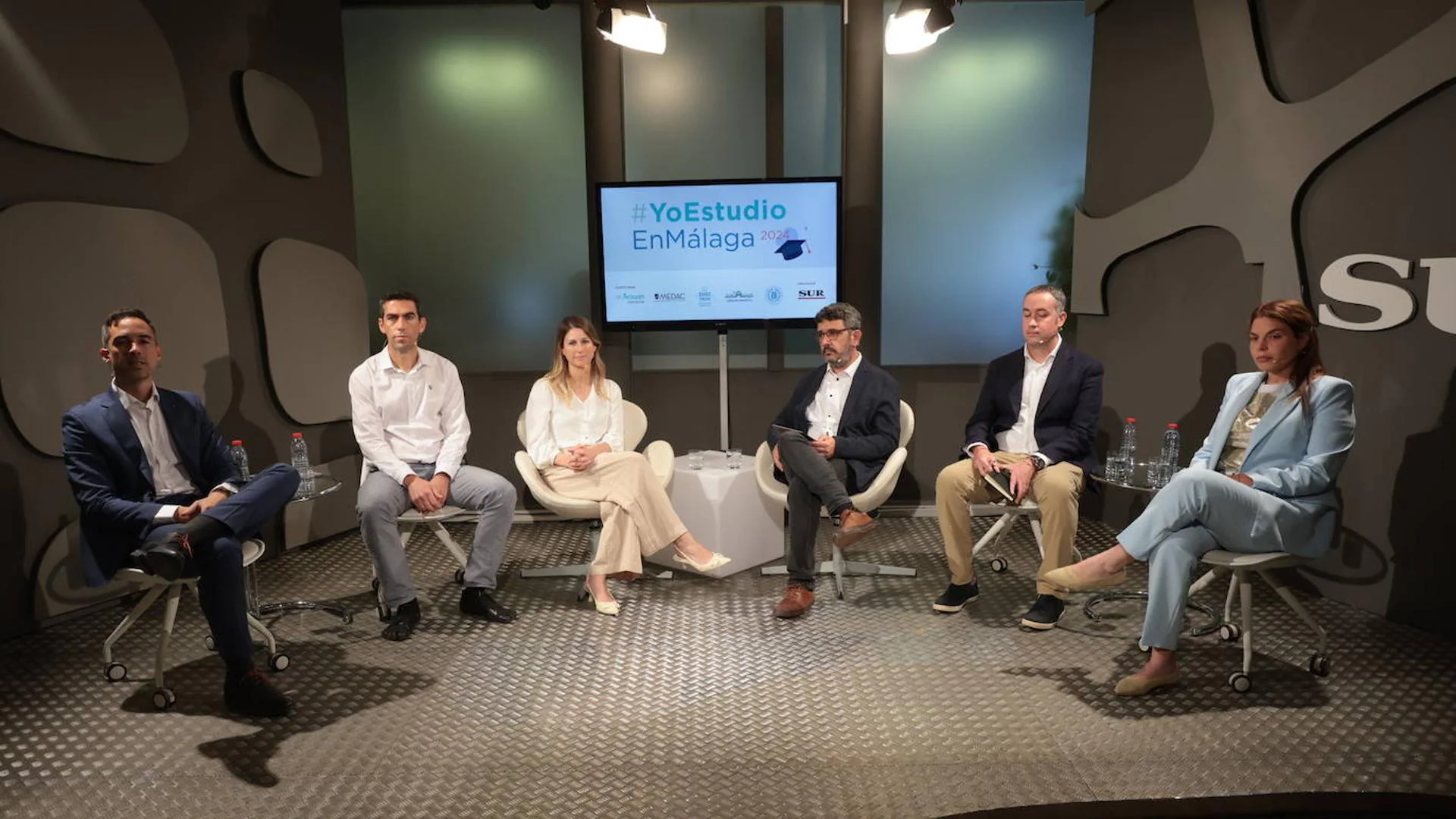Friday, May 24, 2024, 11:34
Undoubtedly, technological advancement has radically changed all areas of our lives, but there are professional fields where its impact is particularly evident. Training participates directly in the technological revolution, not only considering the most advanced resources it provides as teaching tools, but also training professionals who promote the continuation of this progress.
To address the challenges arising from the training-technology binomial, the second panel of the new edition of #YoEstudioenMálaga2024, moderated by journalist Alvaro Baio, had the participation of Marcos Rodríguez, director of Arduán Formación; Fran Santana, Director of MEDAC Malasaña; Raquel Jiménez, Director of Digitech Málaga; Carlos Yáñez, director of SocraTech; and Elizabeth Rogerio, CEO of Sur’Avian.
The talk began with the reflection of professor and business consultant Peter Drucker: “We live in an age of innovation, and practical education must prepare man for jobs that do not yet exist and cannot be clearly defined.”
“Right now we are building the capital of the future, that’s why we have to keep innovating in tools, methods, inventing professional concepts, etc. Specialization, innovation is essential, advances like artificial intelligence are combined with robotics,” explained Marcos Rodríguez. “We have some merit in diagnostic imaging, radiotherapy and dosimetry, where treatments at pioneering oncology centers are already being administered by artificial intelligence-driven robots,” he highlighted.
“In order not to lose the pulse of what is to come, at MEDAC we try to instill in the students interest and commitment to continuous training. We cannot just win the degree and leave. I always tell them that in five years what we explain today will not be valid, so what are they going to do? No, they need to continue training and their specific profession. We have to look at the needs of the sector,” said Fran Santana.
Avoid rejecting change
Raquel Jiménez, at Digitech “We have changed the prism a bit, we focus on students: we help them discover what their motivations and strengths are, and we teach them to break the rejection of change that limits their professional development. Future”.
“The only thing we can be sure of is constant change: there will always be new technologies and they need to keep learning, so it’s important to give them autonomy and teach them where to go to learn something. How to go deeper,” emphasized Carlos Yanez, who is the head of artificial intelligence. He highlighted the possibilities as “a great learning tool to meet the challenges of a changing reality”.
New resources
The CEO of Sur’Avian highlighted a firm commitment to the implementation of new technologies and a careful look at the future of the sector in its training: “From the point of view of the aviation industry, this is an area in progress. At Sur’Avian, airplanes are in continuous evolution, betting on sustainability and efficiency. In the world of aviation we have Analyzing what lies ahead, we have started implementing lessons that will prepare them to use future turbine engines or future fuels. Now we are developing a plan to integrate VR into our training, so that students can jump without a parachute to train, and work without the fear of failure.
Although the pandemic has firmly established telematic training in student habits, the director of Digitec Málaga “stressed the importance of bringing the student as close as possible to the face-to-face educational experience. And more motivation. In this sense, Raquel Jiménez all the center’s classrooms are “connected to streaming, not only as an additional service to our face-to-face students, but also to take advantage of the synergy of individual sessions , all the knowledge we develop in the classroom, we transfer it to the student of the online system.
At the meeting, the breadth of possibilities created by combining face-to-face training with new technologies was affirmed.
Ann

The director of the MEDAC Malasaña Institute recognized that they experience differently the implementation of new technologies in the classroom due to the diversity of their training offer. “We have situations like sports classrooms, for example, no matter how much it is explained behind the scenes, we have to go to the yard, be with the children who lead the company, and do it. The sports facility, he explained sitting in a chair, is not possible. Other training courses are directly related to the technical area. However, what is common is the support of the students.
Following this, Fran Santana debunks the ultimate myth of digital native technological advances: «They consume as digital natives and don’t use it properly, because there are many people who don’t know how to send email, even digital immigrants. “Sometimes a cell phone can be more knowledgeable than the owner who controls its use.”
“Although we believe in an e-learning model, many learning outcomes, such as treating patients humanely, need to be carried over to the classroom, which is important in the healthcare profession. You can learn to use some machines, radiology equipment online, but the most powerful way to learn is in a classroom, which simulates a real clinical environment. ” clarified Marcos Rodriguez. A more diverse profile, and less temporary availability; and working in the classroom with a teacher to promote ‘soft skills’ learning.
Diverse student profile
“At Sur’Avian, we notice how many students coming from the baccalaureate come a little helpless with the idea of abandoning their training, and then we have to find a way to motivate them with training programs for their self-realization. “Elizabeth Rogerio stressed about the motivation of students.
“There is no bigger fan than a convert: at Socrates we get rejected people who are going to give everything to change departments, which will give them all the advantages: schedules, compromise, quality of work, salary … in that way. Because they really want to learn, they make it very easy for us. ,” he commented on a profile of one of his students, Carlos Yance.
In the case of Digitech, Raquel Jiménez commented that both young and adult students consider vocational training as a possibility to change career direction. “We must pay attention to students who do not train: we are finding many mental problems, many interruptions due to the level of stress among young people, and I believe this is an important problem rate, because it means refusing to continue training, because there are no motivations behind it” warned the director of DigiTech Malaga. “There should be a collective commitment from public institutions in educational institutions and families to help them find their vocation,” he added.
“We notice a small tolerance for frustration and a desire to clear the first hurdles: since it is too late to address the problem for the first time at the age of 18, we need to start these problems much earlier in education. ,” he assessed. Fran Santana.
The immediate future of training
Regarding the immediate future of his department, Marcos Rodríguez pointed out, “We have the biggest challenge in the new law: it is a good regulatory structure that helps honor and facilitate professional practice, but this law must be the foundation to answer all the challenges. Face.” Before”.
“We wanted a course that could reach more students, combine face-to-face and non-face-to-face in an active and effective way and ask, ‘Are you studying? In person or online?’,” reflected Bran Santana.
“I want it to be free, flexible and motivating, that is, you can tailor your training to your liking with continuous challenges and modular itineraries, and to be very diverse with many complementary resources,” proposed Raquel Jimenez.
“After the boom in online training brought by the pandemic, the IAS will certainly have an important weight: every new tool is an opportunity to innovate and improve training,” said Carlos Yanez. “I believe in more flexible terms that allow students to decide what they want to study in the way they want, and with more attention to their mental health and motivation so they can go as far as they can because at the end of the day these young people are our future,” he concluded. Elizabeth Rogerio.

